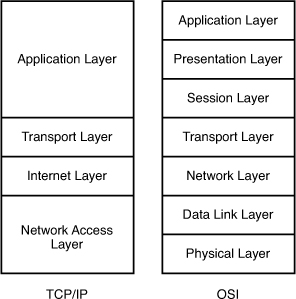OSI TCP/IP Model Questions
Note: If you are not sure about OSI Model, please read our OSI Model tutorial.
Question 1
Explanation
The transport layer segments data into smaller pieces for transport. Each segment is assigned a sequence number, so that the receiving device can reassemble the data on arrival.
The transport layer also use flow control to maximize the transfer rate while minimizing the requirements to retransmit. For example, in TCP, basic flow control is implemented by acknowledgment by the receiver of the receipt of data; the sender waits for this acknowledgment before sending the next part.
-> A is correct.
The data link layer adds physical source and destination addresses and an Frame Check Sequence (FCS) to the packet (on Layer 3), not segment (on Layer 4) -> B is not correct.
Packets are created when network layer encapsulates a segment (not frame) with source and destination host addresses and protocol-related control information. Notice that the network layer encapsulates messages received from higher layers by placing them into datagrams (also called packets) with a network layer header -> C is not correct.
The Network layer (Layer 3) has two key responsibilities. First, this layer controls the logical addressing of devices. Second, the network layer determines the best path to a particular destination network, and routes the data appropriately.
-> D is correct.
The Physical layer (not presentation layer) translates bits into voltages for transmission across the physical link -> E is not correct.
Question 2
Explanation
The Internet Layer in TCP/IP Model is equivalent to the Network Layer of the OSI Model.

Question 3
Explanation
The picture below shows the comparison between TCP/IP model & OSI model. Notice that the Internet Layer of TCP/IP is equivalent to the Network Layer which is responsible for routing decision.

Question 4
Explanation
The Transport Layer segments data into smaller pieces for transport. Each segment is assigned a sequence number, so that the receiving device can reassemble the data on arrival.
The Transport Layer also uses flow control to maximize the transfer rate while minimizing the requirements to retransmit. For example, in TCP, basic flow control is implemented by acknowledgment by the receiver of the receipt of data; the sender waits for this acknowledgment before sending the next part.
-> A is correct.
The Data Link Layer adds physical source and destination addresses and an Frame Check Sequence (FCS) to the packet (on Layer 3), not segment (on Layer 4) -> B is not correct.
Packets are created when network layer encapsulates a segment (not frame) with source and destination host addresses and protocol-related control information. Notice that the network layer encapsulates messages received from higher layers by placing them into datagrams (also called packets) with a network layer header -> C is not correct.
The Network Layer (Layer 3) has two key responsibilities. First, this layer controls the logical addressing of devices. Second, the network layer determines the best path to a particular destination network, and routes the data appropriately.
-> D is correct.
The Physical Layer (not Presentation Layer) translates bits into voltages for transmission across the physical link -> E is not correct.
Question 5
Question 6
Question 7
Explanation
The Internet Layer in TCP/IP Model is equivalent to the Network Layer of the OSI Model.

The first three layers of the OSI Model (Application, presentation and Session Layers) are merged into the Application Layer in the TCP/IP Model.
Question 8


